
Walnut branches (Juglans regia L.) with fruits – Photo by Anna Lacci
Since ancient times the walnut tree has accompanied the history of man, who ate its fruits already 9000 years ago and used all parts of the plant in daily life. It was a very close relationship that over time has characterized the rural landscape and peasant culture; still today in the courtyards of many farmhouses majestic centuries-old walnut trees offer shade, food, and precious wood.
It seems that the Walnut (Juglans regia L.) is native to Western China or the Himalayan massif and that from here the plant passed through the silk road to Asia Minor and then to Greece between the 7th and 5th centuries B.C.
The ancient Romans particularly loved it and spread it throughout the regions of the Empire; in America it was introduced in the seventeenth century by English colonists.
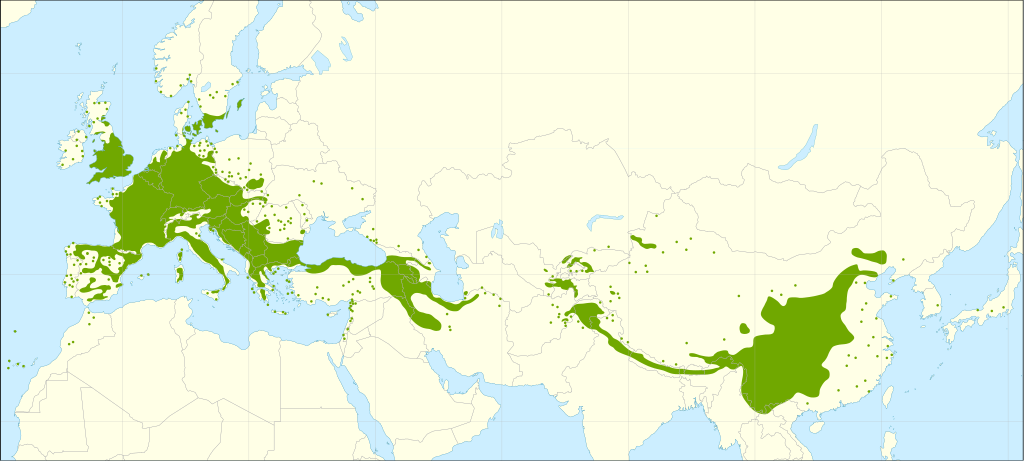
Graphic elaboration by Giovanni Caudullo, CC BY 4.0
The Walnut is a typical plant of the plains and of the first hills; it grows well in the chestnut area between 700 and 1000 meters above sea level, where the soil is deep, fresh, and with good fertility.
It belongs to the Juglandaceae family, which includes about sixty species of trees, divided into seven genera. Very long-lived, even centuries-old, it can reach a height of over 20 meters.
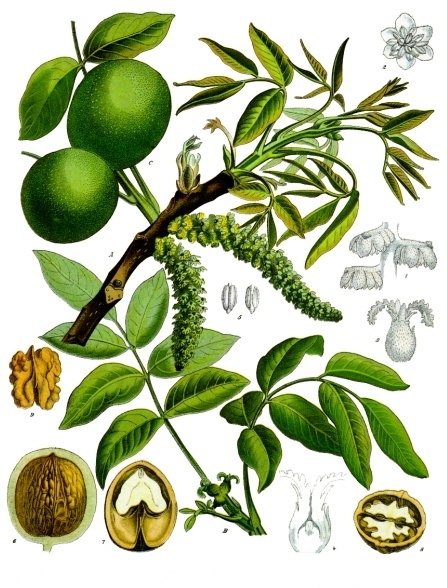
The tree is vigorous, the trunk is straight and imposing, solid and tall; the majestic, wide and expanded crown has a great shading capacity and can reach a diameter of ten meters. In the first twenty years of age of the plant, the bark is smooth and ash gray in colour, but over the years it becomes darker and furrowed with cracks. The diameter of the trunk can even measure one meter.
The leaves, large and fragrant, are light in color and alternate. They are imparipinnate, made up of an odd number of oval leaflets (5-9) with an entire margin, of which 3 apical ones are 5-7 cm long and the basal ones progressively smaller. The apical leaf is always larger than the others. The Walnut is a deciduous tree, it loses its foliage in winter.
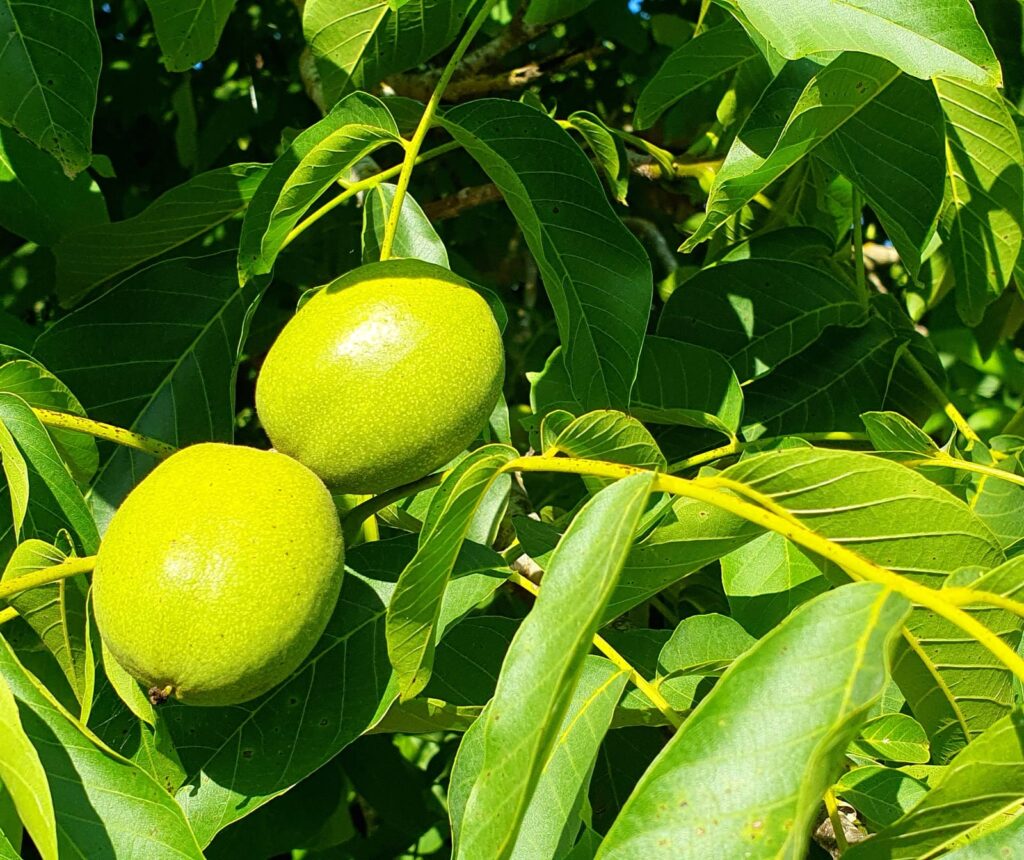
It flowers in April; it is a monoecious plant, i.e. it bears female and male flowers on the same plant.
The male flowers are gathered in pendulous catkins 10 to 15 cm long covered by numerous flowers and appear on the ramifications of the previous year before the appearance of the leaves. The female flowers, usually solitary or gathered in groups of 2-3, form, together with the leaves, after the male ones on the new shoots of the year.
The fruit is an oval drupe composed of a fleshy and green external part (exocarp), the husk, which encloses a woody nut (endocarp) divided into two lodges (shell) which contain the seed called kernel which is the edible part, excellent as a food and rich in oil. Between September and October, when the fruit is ripe, the husk blackens, splits and releases the endocarp, i.e. the nut. In this period the walnut harvest begins and lasts until November.
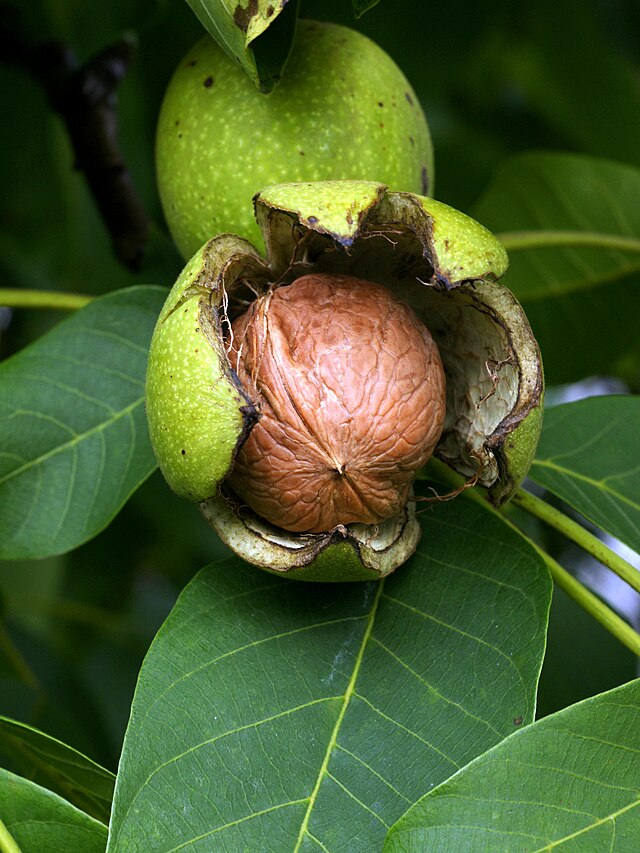
Photo by Böhringer Friedrich from Pixabay
No other plants grow around the walnut, it is a solitary tree. The plant has a toxic substance in the roots, leaves and bark. It is an aromatic organic compound, called juglone, which spreads in the soil and has the property of inhibiting the germination of the seeds of other plants. This phenomenon is called allelopathy. For this reason, the Walnut does not become part of the spontaneous woods.
The root system is also very expanded with taproot roots that absorb a large amount of nutrients and mineral salts from the soil and impoverish the soil.
So little or nothing grows under a walnut tree.
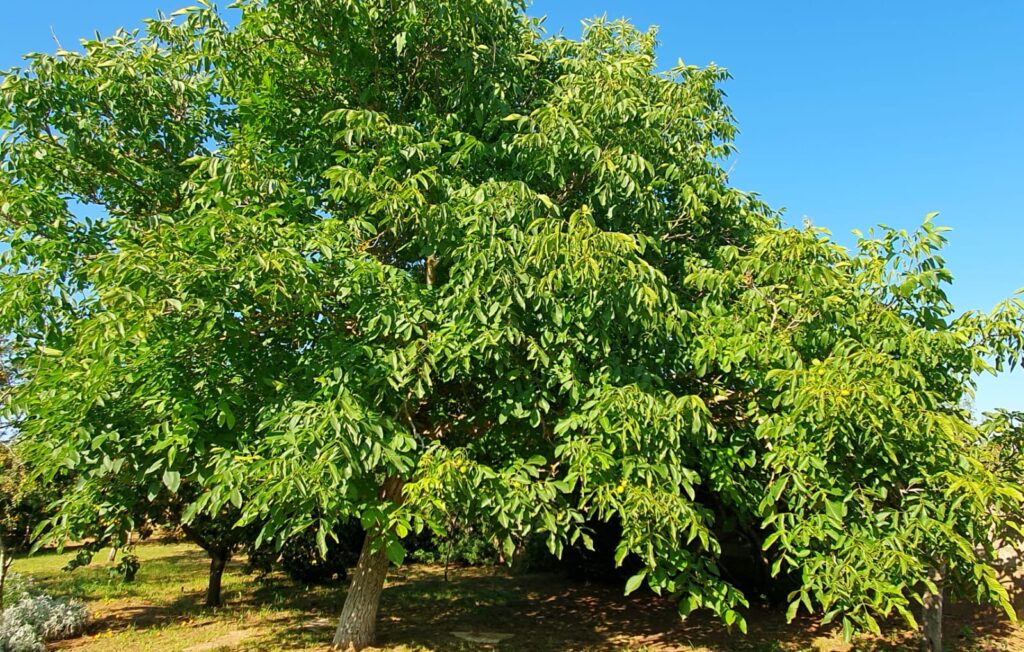
Properties and uses
Every part of the walnut tree and its fruit is useful and usable, starting with its wood. Hard, pleasantly veined and with a characteristic colour, it is considered particularly valuable and used for the production of furniture since Roman times, due to the beauty of its structure and the ease of processing. Commercially it is known in Italy as national walnut.
All parts of the walnut are precious, they contain tannins, juglone, essential oil as active principles; they have bittering, digestive, purifying, hypoglycemic, hypotensive, anti-inflammatory, antiseptic and coloring properties.
The walnut is a real panacea, in addition to proteins and carbohydrates it contains omega3 and omega 6 fats capable of lowering blood cholesterol and preventing cardiovascular diseases. It also contains arginine, phosphorus, copper, zinc, potassium, iron, magnesium and calcium, as well as vitamins B1, B2, B6 and E.
In the past, walnuts played an important role in the daily life of rural communities, making up for the lack of other foods. They were usually eaten with bread and used in the preparation of an oil which was the condiment of poor cooking in areas where the cultivation of ‘olive tree was not possible.
The tannins present in the trunk and in the husk, on the other hand, have always been used for tanning leather and in general as dyes.
The hull was used to dye wool and fabrics, as well as the hair to which it gives a brown tone, a use that has been rediscovered nowadays with natural dyes. Industrial cosmetics use walnut hull oil in the formulation of sunscreen products, due to its ability to stimulate tanning.
The extract of the leaves is instead used in creams and other cosmetic products useful in case of dermatitis, chapping, itching and redness.
Particularly versatile in the kitchen is the inside of the ripe fruit, the kernel, which can be eaten as it is, or for the preparation of various recipes. The whole immature and still green fruit harvested on the night of San Giovanni is the basis for the preparation of Nocino, a bitter and digestive liqueur. The production of Nocino has also established itself in the industrial field.
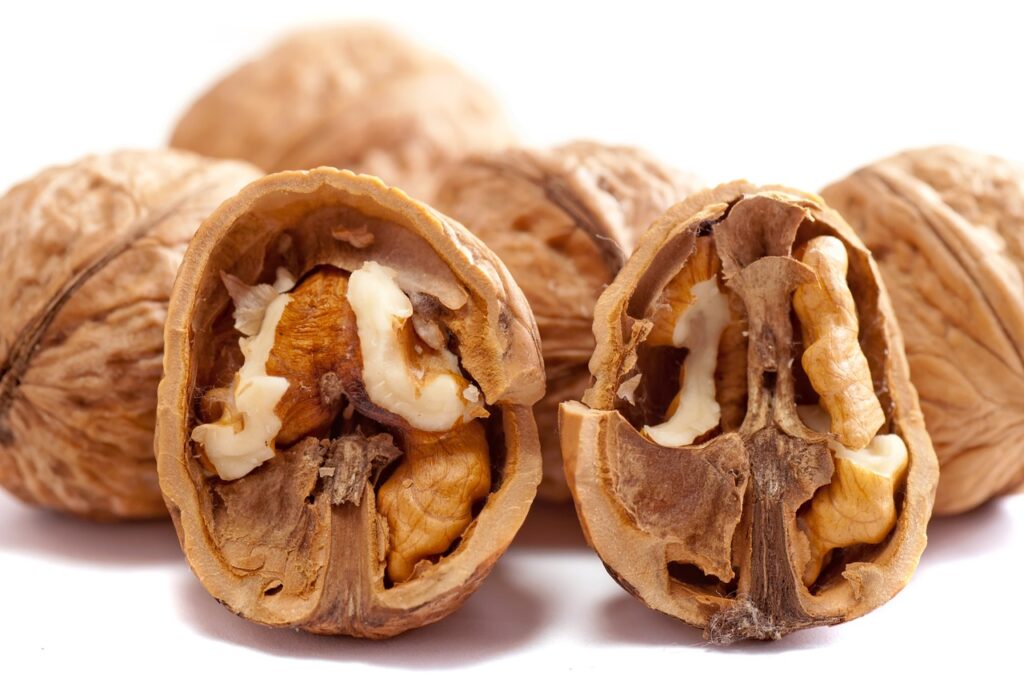
Stories, beliefs and words
The close link with peasant culture, as well as both its importance as food and its majestic structure, has meant that fantasies and beliefs have flourished over the centuries around this plant and its fruit, handed down by popular legends and also reported in the literature.
It was a sacred tree for the Greeks and Romans, consecrated to Jupiter from which the Latin name of the plant derives, meaning “Jupiter’s acorn”.
Greek mythology narrates that Caria, daughter of the king of the Laconians, after her death was transformed into a sacred nut by the god Dionysus. Since then the link between the walnut and female deities became almost essential and, in ancient times, the walnut and its fruits were highly regarded as symbols of fertility and good luck.
The walnut is a plant mentioned even in the Bible (Song of Songs), and is also mentioned by Virgil and Ovid. In the excavations of Pompeii and Herculaneum, charred walnuts of the precious Sorrento variety were found.
In the Middle Ages however, perhaps to demonize the ancient pagan cults, it was believed that witches gathered under a walnut tree for their demonic sabbaths. A large part of the negative beliefs with which the walnut tree is associated depend on its ability not to let trees grow around it and this led to think that there was something evil in the plant.
The best-known walnut is that of Benevento, linked to the Sabbath rituals of the witches It is said that terrible witches gathered at a meeting, on the night of San Giovanni, under the famous Benevento walnut, making the shadow of this plant, and therefore of the walnut in general, harmful both for men and for animals, whether they had stopped there for the cool air or to sleep, causing headaches and fever.
The story dates back to the times when Benevento was the capital of a Lombard duchy and the pagan rituals of the Lombards came into conflict with the religious beliefs rooted in the territory. It seems that the community present there used to gather around the Sabato river (and from here the name given to the Sabbats would later derive) to venerate Odin and the tree in question would have been right near the river.
The walnut tree has thus maintained a sinister role over time and in the popular imagination has become a plant of witches.
However, there are also positive stories: a Slavic legend about the universal flood tells that the right people, destined to repopulate the world, were saved thanks to a nutshell in which they reached the Earth.
Since ancient times, in the peasant world, a walnut tree was planted when a child was born, which over the years would have provided walnuts, a very nutritious and easy-to-preserve food. When the child became an adult and got married, the wood of the same walnut tree was used for the furniture of his new home.
Also in literature there are frequent references to the walnut, from Shakespeare in “Romeo and Juliet”, to Alessandro Manzoni who in Chapter III of The Betrothed, speaks of walnuts in the very famous passage of Fra Galdino’s “begging for walnuts” by Fra Galdino.
It is worth recalling, in solidarity with those who suffer and fight for freedom and democracy in Turkey, the very famous poem by the Turkish poet Nazim Hikmet.
THE WALNUT
My head is a frothy cloud,
the sea is in my chest.
I am a walnut tree in Ghiulkhan park,
grown up, old, branchy – look!
but neither the police nor you know it.
I am a walnut tree in Ghiulkhan park.
And the leaves, like little fish, vibrate from dawn to evening,
they rustle like a silk handkerchief; you take,
Tear them, my dear, and dry your tears.
My leaves are my hands, a hundred thousand green hands,
a hundred thousand hands I reach out, and I touch you, Istanbul.
My leaves are my eyes, and I look around,
with a hundred thousand eyes I look at you, Istanbul.
My leaves beat, like a hundred thousand hearts.
I am a walnut tree in Ghiulkhan park,
but neither the police nor you know it.
Nazim Hikmet
Credits
Maria Beatrice Lupi, a naturalist and expert in training, planning for sustainable development, participatory methodologies, and European planning. Currently, she is involved in dissemination and education for sustainability.
Translation by Maria Antonietta Sessa



